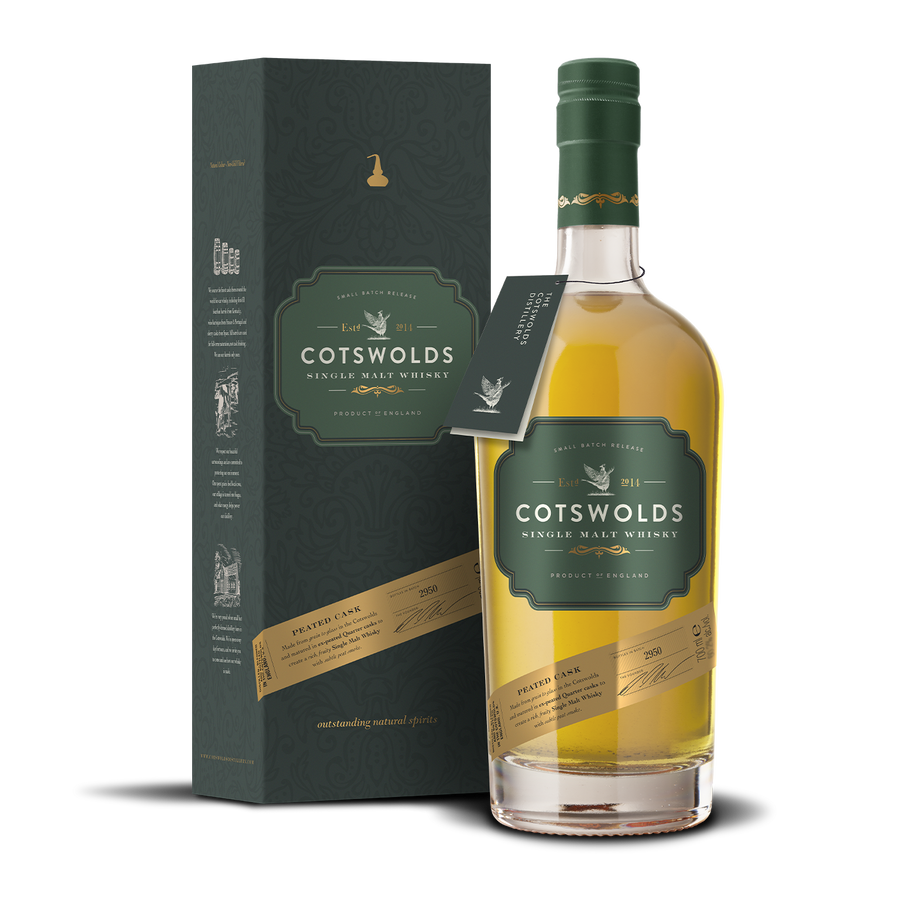What Affects Whisky Flavour? Discover the Influence of Casks, Age, Production, Grain and Peat
There is a mind-bending diversity of flavours in the whisky industry, similarly in just the single malt category – no two are the same. This variety comes down to the complexity of the whisky-making process and the nuances of each region. In this article, we summarise the main factors that affect a whisky’s flavour outcome, from cask selection, age, production techniques, grain choice and the effect of peat.
- Cask influence: the role of barrel selection
- The role of maturation: age is just a number
- Production techniques: the origins of flavour
- Grain choice: the foundation of whisky-making
- Peat: the distinct taste of smoke and earth
Discover the importance of choosing the right barrel – it's more than a container
Older whisky isn’t always better. Dive into what makes aged whiskies popular
We pack our whisky with flavour before it touches the barrel, learn how we do it
A whisky’s mash bill sets the direction for flavour development
The ancient Scottish method is still practised today, and for good reason
Cask Influence: The Role of Barrel Selection
The cask is far more than a maturation receptacle - it plays a key role in shaping the whisky’s overall flavour profile. As the spirit ages, the oak imparts flavour, softens harsh notes and intensifies the complexity through extraction, oxidation and concentration.

Extraction
Alcohol is a powerful solvent that draws out vanillin, tannins, lactones, and spice compounds from the oak. Toasting and charring the barrel caramelises the wood sugars, producing rich flavours like honey, toffee and roasted nuts.
Oxidation
Casks aren’t airtight, which allows subtle oxidation. This gently rounds off harsh aldehydes and develops deeper, more mature flavours over time—think dried fruits, balsamic richness, and mellow spice.
Concentration
As water and ethanol evaporate (known as the ‘angel’s share’), the remaining liquid becomes more concentrated, amplifying flavour intensity.
Cask Seasoning is a Key Ingredient
Whisky should be aged in pre-seasoned barrels, recycled from elsewhere in the industry. There are strict rules for the permissible barrels in Scotch whisky casks. Explore the brief summary of the cask types and their flavour influence:
- Bourbon Barrels (American Oak): Vanilla, coconut, caramel, and orchard fruit.
- Sherry Casks (typically, European Oak): Leather, raisins, baking spice and chocolate (PX), or nuttier, drier profiles (Oloroso).
- STR Casks (Scraped, Toasted, Re-charred): Red fruit, dark sugar, spice and espresso.
- Alternative Seasonings: Rum, port, wine, or even Calvados can add layers of tropical fruit, herbs, or rich toffee notes.
There are two prominent choices of oak species - American oak adds sweetness and baking spice. Meanwhile, European imparts a tannic and more savoury depth.
Dive into the influences of cask selection on whisky flavour
The Role of Maturation: Age is Just a Number
While the barrel type plays the starring role in flavour development, the chemical changes that take place in the cellar involve more than just the wood and its seasoning.

What Happens Chemically as Whisky Ages?
- Dynamic flavour and colour extraction as the wood expands and contracts.
- Oxidation from the surrounding air softens harsh notes and adds complexity.
- Evaporation reduces volume but intensifies the flavour profile.
Over time, smoky and fruity notes may mellow and ripen, allowing rich secondary flavours, such as tobacco, leather, and dried herbs, to rise to the surface. Long maturation sacrifices vibrancy in place of complexity. Meanwhile, over-oaking can lead to tannic and bitter drams.
Is Older Single Malt Whisky Better?
Whisky can become over-matured. Each distillery has a sweet spot depending on cask type, spirit style, production methods, ingredients, grain type and climate. A general rule of thumb is to enjoy vibrant, fruit-forward spirits younger and rich single malt Scotch on the older side.
Insights from an expert
“A six-year-old whisky with a greater angel’s share can have as much depth as a fifteen-year-old Scotch.”
— Rob Patchett, Global Whisky Ambassador
Dive into the significance of whisky maturation
Production Techniques: The Origins of Flavour
Every whisky begins life as a clear, raw spirit, but that doesn’t mean it’s flavourless like vodka. In fact, we pack as much flavour as possible into our white pheasant during the fermentation and distillation stages. Read about single malt whisky production.

Malting & Fermentation
At The Cotswolds Distillery, extended fermentation is key. While most ferment for two days, we double it. This produces an abundance of esters, fatty acids, fusel oils and fruity compounds that we maintain through distillation.
- Longer fermentation = more flavour
- Yeast strain impacts the aroma profile; we use a mix of anchor and fermentis to maximise tropical, citrus and floral notes.
Distillation Precision
Decisions in distillation are often overlooked, but pinpointing cut points determines the flavour compounds that make it to the heart cut. At The Cotswolds Distillery, our master distiller couldn’t be more instrumental to our signature style.
The type of still we use also contributes to a full-bodied flavour. Explore some of our distillation decisions:
- Copper pot stills create rich, flavourful spirit by capturing a broad spectrum of compounds. Compare the still types:
- Pot stills: result in a fuller, fruitier spirit with more body and a lower %ABV.
- Column stills: result in a crisp, clean, light whisky with a higher %ABV, relying more on cask influence.
- Cut points: early cuts lead to a lighter spirit, while later cuts bring oily, bold character.
Insights from an expert
“We’re already pre-loading flavour in production, so the barrels can just add more flavour. It’s about assessing each stage of production - does it make more flavour? Yes, let’s do that”
- Rob Patchett, Global Whisky Ambassador
Dive into the nuances in whisky-making

Grain Choice: The Foundation of Whisky-Making
Grain choice determines the whisky’s backbone—from malty complexity to approachable sweetness or fiery spice. While single malt must be 100% malted barley, grain whiskies (like Bourbon or blended Scotch) introduce a variety of interesting notes. Explore characteristics of malted barley, corn, rye or wheat.
Malted Barley
- It’s the classic and widely adored whisky grain.
- Offers depth, structure, and nutty, cereal notes.
- It adds fruit, honey, floral and subtle spice.
- Peat drying is common in malt whisky and introduces distinct smoke.
Corn (also called maize)
- Used as the staple grain in Bourbon.
- High sugar, low protein content results in a sweet, light and approachable spirit.
- Enjoy undertones of buttered popcorn, honey and green apple.
Rye
- This grain is big, bold and spicy.
- Guaiacol adds pepper, clove, and barbecue heat – it adds a savoury hit to Bourbon.
- Rye creates a chewy mouthfeel and dry finish.
Wheat
- The approachable flavour profile softens blended mash bills.
- It creates a light body, delicate sweetness and floral esters.
- Harmonises rye and malted barley, which are complex and rich.
Mixed mash bills are used to create the perfect balance—wheat for softness, rye for kick, corn for sweetness. Malt whiskies are only permitted to use malted barley and Bourbon must contain at least 50% corn. However, in general, grain whiskies offer a diverse and exciting range of flavour profiles.
Dive into the significance of grain selection on whisky flavour

Peat: The Distinct Taste of Smoke and Earth
Few flavours in whisky are as divisive or iconic as peat. Derived from decomposed vegetation and boggy soils, peat is used to dry malted barley, imparting a smoky profile that travels from grain to glass.
Peat Compounds
Below are the chemical groups that give peat-dried barley its distinct flavour
- Guaiacol: Smoky, woody
- Syringol: Sweet campfire
- Cresols: Medicinal, iodine
- Phenol: Earthy, herbal
- 4-Methylguaiacol: Meaty, barbecue spice
These compounds are heat-stable, meaning they survive distillation and mellow over time, deepening into notes of tobacco, leather, herbs and disinfectant.
Deciphering Peat Levels
Phenols are measured in PPM (parts per million), and whisky can range from unpeated (0–5 PPM) to extremely peated (100+ PPM). The Cotswolds Peated Cask offers a subtle approach—just a hint of smoke with lots of vanilla and vibrant fruit.
What Affects Peatiness?
- Peat source (surface vs. deep) changes flavour from floral to medicinal.
- Smoking time and moisture of the grain determine absorption.
- Distillation choices affect which phenols make it into the final dram.
Dive into the influences of peat on whisky flavour
Final Thoughts: Flavour is a Sum of Its Parts
The magic of whisky lies in its complexity. Carefully selected casks introduce new flavours, age softens and deepens, production packs in flavour from the start, grains set the scene, and peat offers that unmistakable smoky signature.

